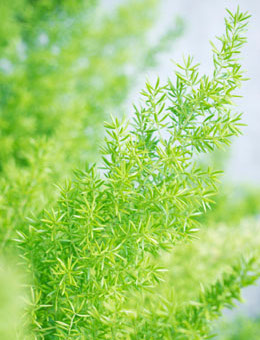The asparagus fern is generally grown as a houseplant in pots and hanging baskets. The care for this plant involves providing optimum growth conditions, which include adequate sunlight, water and using well-drained and nutrient-rich soil. In this following Buzzle article, we will go into a little more detail about the factors involved in its care.

Asparagus fern is a perennial shrub, native to South Africa and certain parts of Asia. The scientific name of this plant is Asparagus
densiflorus. This fern is considered a weed that belongs to the lily family. Even though it is considered a weed, it is also a popular ornamental houseplant, and looks especially great in a hanging basket.
The plant, however, is not a true fern, it is rather, a relative of the asparagus plant. But because its delicate and feathery foliage resembles the leaves of a fern, it has been named thus. In this following Buzzle article, we will take you through the varied factors required in growing this fern. These are not very difficult―all one needs is to provide favorable growth conditions for the same.
Physical Attributes
The asparagus fern is a perennial, branching shrub with tough, green aerial stems, which have a number of spines. The leaves are very delicate and can grow up to a length of about 0.8 to 2 cm and width of 0.1 to 0.2 cm. These leaves are not true leaves. They are cladodes that look like and perform the functions of normal leaves. These cladodes usually appear in groups of four or more.
The actual leaves of the asparagus fern, on the other hand, take the form of spines. The plant is also characterized by a dense mat of fibrous roots with bulbous tubers. It produces small and inconspicuous, white or pinkish flowers in the spring. The flowers are bell-shaped and are found to occur in clusters. The plant also produces green colored berries, that turn red, when mature. These berries contain one or more seeds that are black in color, and are used for further propagation of the plant.
Maintenance Factors
The fern is mainly grown as a houseplant in cooler climates, or as an ornamental plant in gardens and in pots. It grows well in bright light and needs only moderate water levels. The fern can tolerate low light conditions as well. Usually, a place that receives bright, but indirect sunlight is ideal for growing the same. If you are planning to grow this plant inside your house, then you can place it near a window, so that it can get bright, but filtered sunlight.
As far as the soil type is concerned, it prefers moist, sandy, or loam soil types. The soil should be rich in nutrients and well-drained. Therefore, it is preferable to mix peat moss and sand with the soil before plantation. Since it does well in moderate water levels, allow the soil to dry before watering the fern. However, under watering can give rise to certain problems like yellowing of foliage, and drooping of the needles of the plant; so it needs to be kept in mind that adequate water is provided. Therefore, providing the optimum level of water is a crucial part of its care.
The fern prefers a humid environment for growth, and so, keeping a humidity tray along with regular misting can prove beneficial for the healthy growth of the fern. Once the plant starts to grow rapidly, its root ball can begin to bulge out or overcrowd the pot. In such a situation, you can either opt for transferring the fern to a bigger pot or container, or divide the root ball into two parts and propagate a new plant.
Asparagus ferns also need a fertilizer at times, depending on how rapidly they grow. The best time for fertilization is in the spring or early fall period, though fast growing plants can be fertilized once in a month with a water-soluble fertilizer. In case the growth rate is moderate, then fertilizing once in alternate months will suffice.
It is not often that the plant is afflicted by pest problems. Though, mealy bugs and spider mites may attack the fern in rare occasions. If this happens, it is important that you contact a professional for the same.
With proper care, this plant with its lacy and delicate foliage, and bushy appearance can be an excellent addition to your house. However, if you have pets, there is a need to be a little cautious. This plant can be toxic to cats and dogs and its berries can cause gastrointestinal problems like, stomach pain, vomiting, and diarrhea, if ingested. Even skin contact with the plant can cause allergic reactions and dermatitis in some. So, pet owners need to take appropriate precautionary measures to keep their pets away from this houseplant.






 Asparagus fern is a perennial shrub, native to South Africa and certain parts of Asia. The scientific name of this plant is Asparagus densiflorus. This fern is considered a weed that belongs to the lily family. Even though it is considered a weed, it is also a popular ornamental houseplant, and looks especially great in a hanging basket.
Asparagus fern is a perennial shrub, native to South Africa and certain parts of Asia. The scientific name of this plant is Asparagus densiflorus. This fern is considered a weed that belongs to the lily family. Even though it is considered a weed, it is also a popular ornamental houseplant, and looks especially great in a hanging basket.